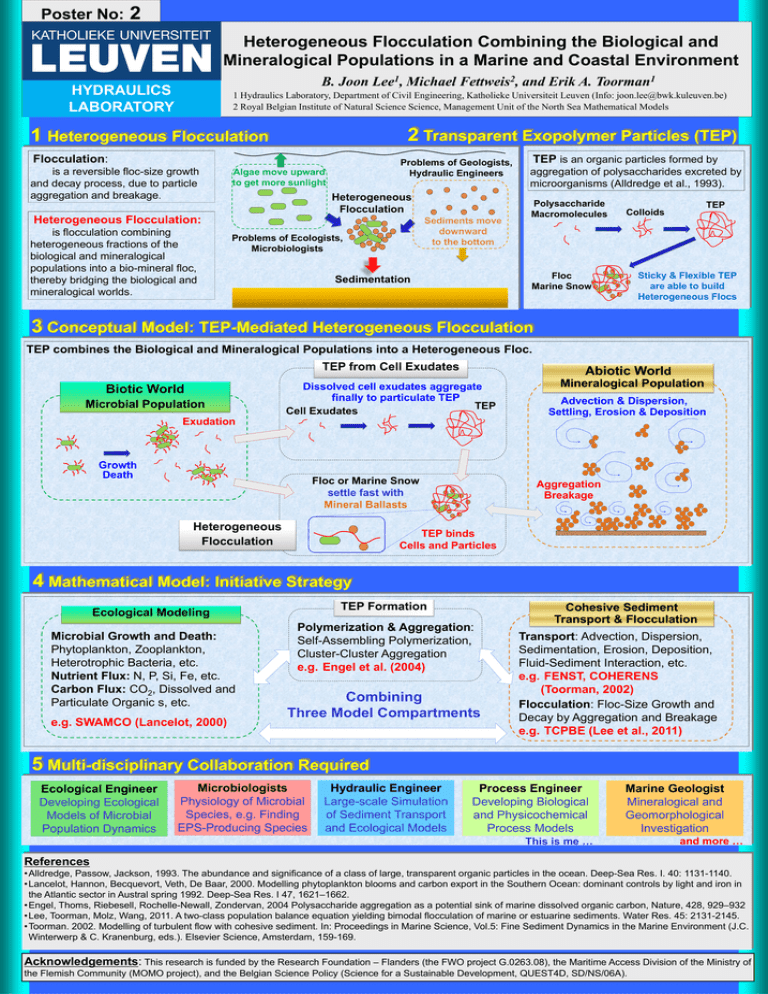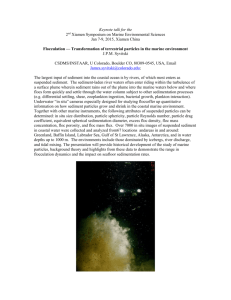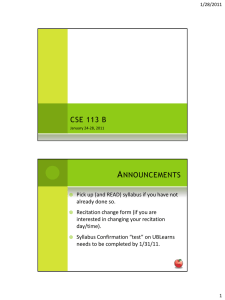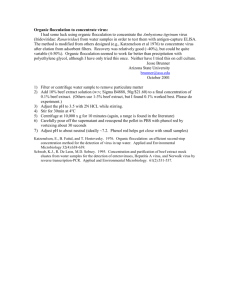2
advertisement

Poster No: 2 Heterogeneous Flocculation Combining the Biological and Mineralogical Populations in a Marine and Coastal Environment B. Joon Lee1, Michael Fettweis2, and Erik A. Toorman1 HYDRAULICS LABORATORY 1 Hydraulics Laboratory, Department of Civil Engineering, Katholieke Universiteit Leuven (Info: joon.lee@bwk.kuleuven.be) 2 Royal Belgian Institute of Natural Science Science, Management Unit of the North Sea Mathematical Models 2 Transparent Exopolymer Particles (TEP) 1 Heterogeneous Flocculation Flocculation: is a reversible floc-size growth and decay process, due to particle aggregation and breakage. Problems of Geologists, Hydraulic Engineers Algae move upward to get more sunlight Heterogeneous Flocculation Heterogeneous Flocculation: is flocculation combining heterogeneous fractions of the biological and mineralogical populations into a bio-mineral floc, thereby bridging the biological and mineralogical worlds. Sediments move downward to the bottom Problems of Ecologists, Microbiologists TEP is an organic particles formed by aggregation of polysaccharides excreted by microorganisms (Alldredge et al., 1993). Polysaccharide Macromolecules Colloids Sticky & Flexible TEP are able to build Heterogeneous Flocs Floc Marine Snow Sedimentation TEP 3 Conceptual Model: TEP-Mediated Heterogeneous Flocculation TEP combines the Biological and Mineralogical Populations into a Heterogeneous Floc. TEP from Cell Exudates Biotic World Microbial Population Abiotic World Dissolved cell exudates aggregate finally to particulate TEP TEP Cell Exudates Mineralogical Population Advection & Dispersion, Settling, Erosion & Deposition Exudation Growth Death Floc or Marine Snow settle fast with Mineral Ballasts Heterogeneous Flocculation Aggregation Breakage TEP binds Cells and Particles 4 Mathematical Model: Initiative Strategy TEP Formation Ecological Modeling Microbial Growth and Death: Phytoplankton, Zooplankton, Heterotrophic Bacteria, etc. Nutrient Flux: N, P, Si, Fe, etc. Carbon Flux: CO2, Dissolved and Particulate Organic s, etc. e.g. SWAMCO (Lancelot, 2000) Polymerization & Aggregation: Self-Assembling Polymerization, Cluster-Cluster Aggregation e.g. Engel et al. (2004) Combining Three Model Compartments Cohesive Sediment Transport & Flocculation Transport: Advection, Dispersion, Sedimentation, Erosion, Deposition, Fluid-Sediment Interaction, etc. e.g. FENST, COHERENS (Toorman, 2002) Flocculation: Floc-Size Growth and Decay by Aggregation and Breakage e.g. TCPBE (Lee et al., 2011) 5 Multi-disciplinary Collaboration Required Ecological Engineer Developing Ecological Models of Microbial Population Dynamics Microbiologists Physiology of Microbial Species, e.g. Finding EPS-Producing Species Hydraulic Engineer Large-scale Simulation of Sediment Transport and Ecological Models Process Engineer Developing Biological and Physicochemical Process Models Marine Geologist Mineralogical and Geomorphological Investigation This is me … and more … References •Alldredge, Passow, Jackson, 1993. The abundance and significance of a class of large, transparent organic particles in the ocean. Deep-Sea Res. I. 40: 1131-1140. •Lancelot, Hannon, Becquevort, Veth, De Baar, 2000. Modelling phytoplankton blooms and carbon export in the Southern Ocean: dominant controls by light and iron in the Atlantic sector in Austral spring 1992. Deep-Sea Res. I 47, 1621–1662. •Engel, Thoms, Riebesell, Rochelle-Newall, Zondervan, 2004 Polysaccharide aggregation as a potential sink of marine dissolved organic carbon, Nature, 428, 929–932 •Lee, Toorman, Molz, Wang, 2011. A two-class population balance equation yielding bimodal flocculation of marine or estuarine sediments. Water Res. 45: 2131-2145. •Toorman. 2002. Modelling of turbulent flow with cohesive sediment. In: Proceedings in Marine Science, Vol.5: Fine Sediment Dynamics in the Marine Environment (J.C. Winterwerp & C. Kranenburg, eds.). Elsevier Science, Amsterdam, 159-169. Acknowledgements: This research is funded by the Research Foundation – Flanders (the FWO project G.0263.08), the Maritime Access Division of the Ministry of the Flemish Community (MOMO project), and the Belgian Science Policy (Science for a Sustainable Development, QUEST4D, SD/NS/06A).


